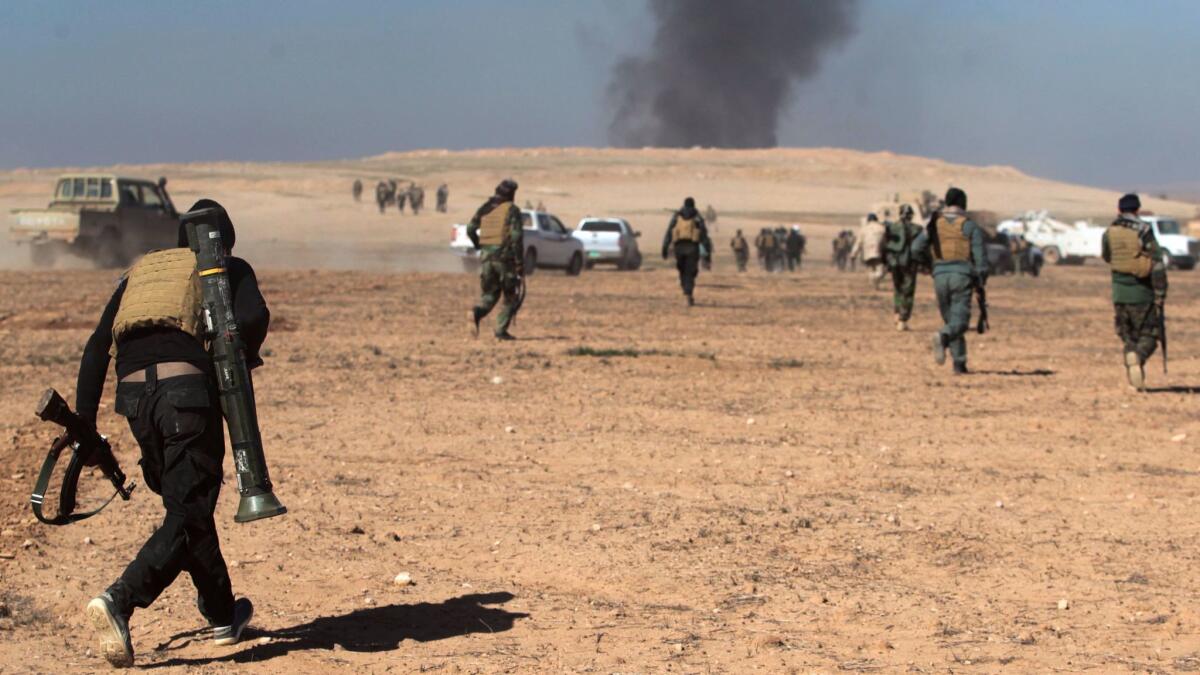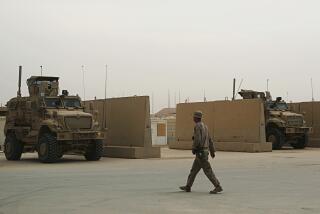U.S. advisors are now fighting alongside Iraqi forces in the battle for Mosul

The Mosul campaign begins again. (Video by Nabih Bulos / Los Angeles Times)
- Share via
Reporting from Baghdad — U.S. military advisors are now fighting alongside Iraqi forces near the front lines against Islamic State, a sign of President Trump’s willingness to grant more latitude to American commanders than they’ve had since Iraq’s ground war against the militants was launched more than two years ago.
The Trump administration has not yet granted new authorities, but has loosened the reins for U.S. generals running the war, allowing hundreds of U.S. troops to join advancing Iraqi forces as they embark on their most complex mission to date: liberating Mosul, their second largest city.
For the record:
2:18 p.m. June 23, 2019An earlier version of this article said that Defense Secretary James N. Mattis retired as a four-star general in 2014. He retired in 2013.
Allowing U.S. forces to head to the leading edge of the battle was almost unthinkable under the Obama administration, which was reluctant to be seen as putting American lives in harm’s way in a foreign war.
In recent weeks, however, about 450 U.S. special forces and spotters have traveled with the Iraqis to direct airstrikes against Islamic State positions and advise Iraqi ground commanders on how best to advance on the battlefield as they move to free west Mosul, said Lt. Gen. Stephen Townsend, commander of U.S. forces in Iraq and Syria.
“It is true that we are operating closer and deeper into Iraqi formations,” he told reporters at a military outpost at Baghdad International Airport. “We adjusted our posture during the east Mosul fight, and we embedded advisors a bit farther down into the formation.”
Townsend made the disclosure during James N. Mattis’ first visit to the Iraqi capital as Defense secretary. Mattis plans to submit a more aggressive battle plan to defeat Islamic State to the White House by month’s end, and he hinted a willingness to grant more leeway to U.S. officers overseeing the war.
“We’ll accommodate any requests from the field commanders,” he said. “Right now, our allies -- as you can tell from the casualty lists -- are carrying the overwhelming burden of this fight in their own territory.”
The authority to put U.S. forces near combat lines, rather than back at headquarters, was quietly granted in November under President Obama in his last days of office.
It wasn’t clear why Obama granted the authority, but U.S. generals running the fight against Islamic State appear to be embracing newfound freedom under Trump to make full use of it.
Additionally, Trump ordered Mattis to devise a new battle plan to defeat Islamic State. It’s due at the end of the month.
The Pentagon didn’t publicly announce the change in protocol, but it became apparent Sunday after scores of uniformed U.S. soldiers were seen fighting shoulder-to-shoulder with Iraqi forces in the assault on west Mosul, the Islamic State’s last major stronghold in the country.
U.S. forces now go “as close as they need to get,” said Col. John Dorrian, a spokesman for the campaign against Islamic State.
Iraqi Prime Minister Haider Abadi announced the much-anticipated assault early Sunday, and by nightfall roughly five square miles had been recaptured on the southern outskirts of the western bank of the Tigris River.
Iraqi forces pressed their attack Monday, getting to within striking distance of the city’s southern entrance on the second day of their offensive.
Iraq’s official combat media said units from the federal police and its special forces arm, the emergency response division, had wrested control of Albu Sayf, the last Islamic State-held area before the city. The latest push brings the troops within striking distance of Mosul’s airport at the southern edge of the city.
A second prong of the attack cleared a stretch of the Baghdad-Mosul highway leading into the city, further tightening a weeks-long blockade on the western half of Mosul.
Mosul, which is bisected by the Tigris River, was seized by a skeleton force of Islamic State militants who swatted away a government force of some 20,000 men in the summer of 2014. It became the extremist group’s Iraqi capital: Abu Bakr Baghdadi, the group’s leader, announced the creation of a “caliphate” in a mosque in west Mosul’s Old City.
Since then, security forces have been eager at a chance for redemption. They got it in October, when the government, backed by the U.S.-led coalition, began its campaign, taking the city’s eastern bank after 100 days of fighting so intense that it forced the government to take a break.
On Monday afternoon, convoys comprising dozens of Humvees, mine-protected vehicles and construction trucks from the Iraqi counter-terrorism service were gathering near the village of Athbah, six miles from the city.

The counter-terrorism service, an elite U.S.-trained group that specializes in urban warfare, has led the charge against every Islamic State bastion, including east Mosul. It will face a potentially more difficult job in the city’s western districts, home to an estimated 750,000 to 800,000 people packed in a more densely populated area.
Iraqi officials say the terrain of west Mosul makes clear the need for U.S. military advisors to work alongside and help direct precision airstrikes. The ancient city is densely populated with narrow streets, alleyways and close-built communities. One miscalculation could lay generations of antiquities to waste.
Sabeh Noman, spokesman for the Iraqi military’s elite counter-terrorism service, said there is little room for error. Combat vehicles are too wide to navigate through many streets, so the Iraqis will be locked in house-to-house urban combat.
East Mosul was liberated last month by Iraqi forces. The four-month operation was hard-fought and backed by hundreds of U.S.-led coalition airstrikes.
In that part of the city, a fighter jet could drop a 2,000-pound bomb to destroy a building, U.S. Air Force Brig. Gen. Matt Isler said. On the west side, that same bomb would take down eight buildings.
Having a U.S. spotter to help deliver airstrikes mitigates against leveling city blocks, Isler said.
Trump repeatedly said on the campaign trail that he would make a priority of defeating Islamic State, and went so far as to call Obama the “founder” of the group for presiding over the conditions that led to its creation. In his inaugural address, he vowed to “eradicate” Islamist terrorism “completely from the face of the Earth.”
Whether the new military blueprint under Trump will speed the end of the battle against Islamic State is far from certain, but Iraqi officials believe it will be crucial against the 2,000 militants still inside the city.
Ousting the Sunni Muslim extremists from Mosul is a major objective for Abadi’s fragile government. He has set a goal of regaining control of his nation’s territory and borders by the end of this year.
There is no question that a successful U.S.-backed assault with 50,000 Iraqi and Kurdish troops on a major urban center would mark a turning point in a war that has been slow-moving, with constant setbacks, since the Iraqi forces abandoned the city and left their weapons behind in 2014.
Even with U.S. special operations troops near the battle, Iraqi troops have the greater burden of evicting the militants and securing the city.
When Mattis stepped off the C-17 cargo plane into the morning sun, it marked his first return to the war-torn country where he spent years in combat as a Marine Corps officer before retiring as a four-star general in 2013.
He said he was heartened by his discussions with Abadi and other senior Iraqi government officials despite the near-constant war in Iraq for more than two decades.
“There’s been a lot of rocky times out here,” he said. “There is no doubt from my discussions today that the Iraqi people, the Iraqi military, and the Iraqi political leadership recognize what they’re up against.”
Times staff writer Hennigan reported from Baghdad and special correspondent Bulos from Athbah, Iraq.
Twitter: @wjhenn
ALSO:
Climate change is real: Just ask the Pentagon
Overweight, tattooed, stoned? The Pentagon may still want you
More to Read
Sign up for Essential California
The most important California stories and recommendations in your inbox every morning.
You may occasionally receive promotional content from the Los Angeles Times.











